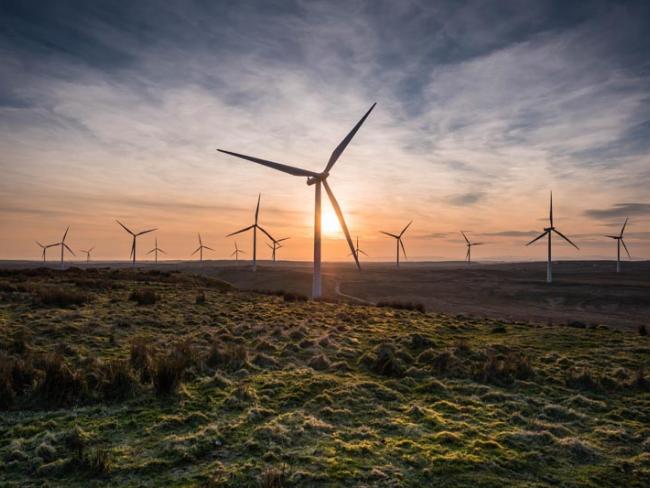
Whitelee Wind Farm, the largest wind farm in Britain, owned by a subsidiary of Spanish multinational Iberdrola (main shareholder Qatar). Photo Ian Dick, Flickr (CC BY-2.0).
It’s not enough to say that renewable energy is the solution to environmental woes. Technology alone will fail. What is needed is long-term planning, and we are a long way away from that…
There can be little doubt that the burning of fossil fuels, particularly in the age of industrialisation, has seen a rise in the concentration of carbon dioxide in the Earth’s atmosphere. According to the US National Oceanic and Atmospheric Administration, which measures CO2 in the air, the level is now 421 parts per million, an increase of 50 per cent from pre-industrial levels.
Few people would want to do away with the advances in agriculture, industry, health and welfare that industrialisation has made possible. But debate tends to be about how we transition to a carbon free future as quickly as possible. Net zero is the given – it is just the method of achieving it that is called into question.
Moving away from fossil fuels is a legitimate goal. Once you’ve used coal, gas and oil you can’t re-use it. You can’t make more. Hence the appeal of the renewable energy argument. The chief difficulty is that the means of converting potential renewable power into reliable, continuous and affordable energy is yet to be developed.
Green jobs?
Idle talk about “green” jobs abounds whenever industrial destruction is announced. But where are the green jobs promised to Durham, Yorkshire, and Wales to replace the coal industry? Sparse, superficial, and cosmetic at best. Instead, the towns and communities in those abandoned areas suffer neglect.
Among alternative sources of energy, wind power has many advocates, and the associated technology is continually progressing. But carefully consider the downsides. The fossil fuel driven construction and installation of modern turbines must be set against the supposed carbon-free end product.
‘The power generated on a windy day must be transported over great distances, further reducing efficiency…’
They impact on the landscape. Pylons need to be built in windy places, which in Britain equates with remote and much loved rural sites, far from the population centres which need power. And the latest models at 280 metres are taller than any building in Britain except the Shard in London (310 metres).
The power generated on a windy day must be transported over great distances, further reducing efficiency, and necessitating huge grid and infrastructure updates. Pylon construction requires steel, concrete, fibreglass, copper and rare earth materials. Their mining, processing and transporting add hugely to the upfront costs.
Solar panel waste
Much the same can be said of the solar panels now springing up in vast arrays across the British countryside. As with wind turbines, the production of solar panels is anything but green. Silica-rich sand is mined and processed to produce high grade silicon, which is the first step in an intensive industrial process – consuming energy and producing waste (not all of which is recycled). The rare earths required generate 2,000 tons of toxic waste for every ton produced.
Most disastrous of all is the loss of productive farmland. The inducements paid to landowners to site pylons, windfarms and solar panels on their land means many of them cannot resist a fast buck. Instead of using land to produce food, taxpayers’ money is spent to increase our dependence on imported food.
Then come the days when the wind doesn’t blow and the sun doesn’t shine. We’ve come a long way since windmills made flour and the sun made salt from seawater, but wind and sun can only be viewed as complementary to more reliable sources of power.
More contentious is burning biomass (usually wood pellets) for power generation. Britain’s biggest power station, Drax in North Yorkshire, was converted to burn biomass, and currently supplies about 4 per cent of our electricity needs.
But biomass relies on subsidies and tax breaks which disguise the true cost of electricity produced this way. Not to mention the environmental impact of deforestation in those parts of the world where the wood is grown. Characterising biomass as “renewable” is now in question.
Other legitimate forms of energy such as hydropower and tidal power are of limited applicability and can’t easily be scaled up. Their contribution to the overall energy mix is small.
Hydrogen
Hydrogen offers promise in the transport sector. A small number of cars and vans are already in production. But “blue” hydrogen, currently the most widely used form in industry, is produced using steam methane reforming, a highly carbon-emitting process that also releases methane.
‘The elephant in the room when discussing energy is nuclear…’
“Green” hydrogen is split from water by electrolysis, with the power for the process fuelled by wind power. It is an expensive technology, in its infancy in terms of large scale production. Again the real cost is masked by wind subsidies.
The elephant in the room when discussing energy is nuclear. Admittedly, startup costs are very high, though Small Modular Reactors can be more efficiently produced off site. Some new generation nuclear power stations are now certified for 80 years of operation.
They can generate power 24 hours a day whatever the weather. In use, they produce virtually zero carbon dioxide or other greenhouse gases. Concerns about the disposal of spent fuel from reactors remain, though Britain has pioneered methods for safe storage, and some designs produce spent fuel which can be treated and re-used.
Design improvements have reduced the risk of accidental meltdowns or vulnerability to targeted attacks. Public acceptance of the central importance of nuclear being a key component of our energy mix is growing. What must grow alongside it is the willingness to commit to the long-term planning for all energy sources which is vitally necessary.
Renewables are improving, but remain a long way from being the solution.
